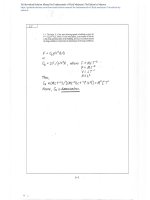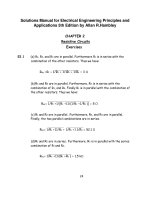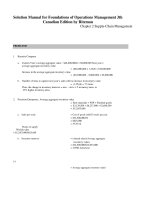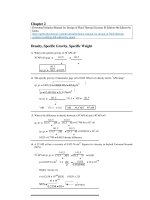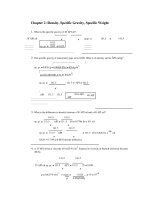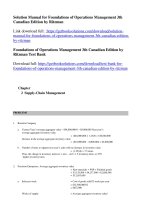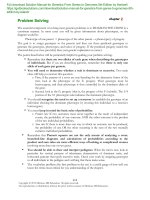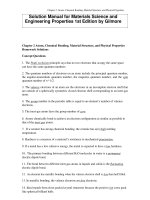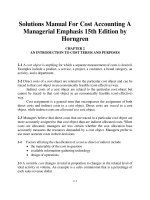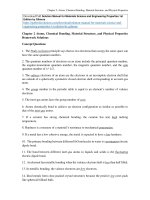Solution manual for design of fluid thermal systems SI edition 4th edition by janna download
Bạn đang xem bản rút gọn của tài liệu. Xem và tải ngay bản đầy đủ của tài liệu tại đây (1.84 MB, 43 trang )
Chapter 2 :Density, Specific Gravity, Specific Weight
1. What is the specific gravity of 38◦API oil?
1 .5
◦
1 .5
A
3
+◦
38 API oil
sp.gr. =
+
141.5
=
141 .5
141.5
sp. gr. = 169.5 = 0.835
◦
2. The specific gravity of manometer gage oil is 0.826. What is its density and its API
rating?
3
sp. gr. = 0.826; ρ = 1000(0.826) = 826 kg/m
3
ρ = 62.4(0.826) = 51.54 lbm/ft
sp. gr. =
131.5 + ◦API = 141.5
141.5
131.5
0.826
API
+◦
◦
−
=
API
171.3
;
◦
131.5
=
39.8◦API
≈
API
◦
40 API
3. What is the difference in density between a 50◦API oil and a 40◦API oil?
141.5
sp. gr. = 131.5
141.5
API = 131 .5
◦
50 = 0.7796 for a 50 oil
+◦
+
141.5
141.5
◦
40◦
sp. gr. = 131.5 API
= 131.5 40 = 0.826 for a
oil
+
+
0.825 − 0.7796 = 0.0455 density difference
4. A 35◦API oil has a viscosity of 0.825 N·s/m2. Express its viscosity in Saybolt Universal Seconds
(SUS).
141.5
141.5
◦
◦API = 131.5
35 AFI oil sp. gr. = 131.5
+
2
μ = 0.825 N·s/m
ν = μgc =
35 = 0.850
+
= 10 × 10
0.825
)
−4
Highly viscous; try
ν = 0.2158 × 10
−6
(SUS)
if SUS > 215
−4
10 × 10
SUS =
0.2158 × 10−6
=
4633 SUS
c 2015 Cengage Learning. All Rights Reserved. May not be scanned, copied or duplicated, or posted
to a publicly accessible website, in whole or in part.
2-1
3
5. Air is collected in a 1.2 m container and weighed using a balance as indicated in Figure P2.5. On
◦
3
the other end of the balance arm is 1.2 m of CO2. The air and the CO2 are at 27 C and atmospheric
pressure. What is the difference in weight between these two volumes?
CO2
air
FIGURE P2.5.
◦
3
Air at 27 C = 300 K has ρ = 1.177 kg/m CO2
◦
3
at 27 C = 300 K has ρ = 1.797 kg/m
3
For a volume of 1.2 m , the weight of air is
3
3
2
(1.177 kg/m )(1.2 m )(9.81 m/s ) = 13.86 N
For CO2
3
3
2
(1.797 kg/m )(1.2 m )(9.81 m/s ) = 21.15 N Weight
difference is 21.15 − 13.86 = 7.29N
6. A container of castor oil is used to measure the density of a solid. The solid is cubical in shape, 30
mm × 30 mm × 30 mm, and weighs 9 N in air. While submerged, the object weighs 7 N. What is the
density of the liquid?
3
Castor Oil ρ = 960 kg/m
mg −mg
buoyant force
volume
in air
=
9−7 1 ρ 3
submerged
= ρg
V
3
7 551 kg/m
= (0.03) 9.81 =
7. A brass cylinder (Sp. Gr. = 8.5) has a diameter of 25.4 mm and a length of 101.6 mm. It is submerged
in a liquid of unknown density, as indicated in Figure P2.7. While submerged, the weight of the
cylinder is measured as 3.56 N. Determine the density of the liquid.
weight
submerged
object
Buoyant force = mgin air − mgsubmerged = mg − 0.8
FIGURE P2.7.
mg − 0.8
buoyant force
ρg
π
V
D2
2
h π (0.0254) (0.1016)
=
volume
=
=
V
=
4
= 4
5.15
3
10 5 m
×
−
−5
mg = ρbV g = 8500(5.15 × 10 )(9.81) = 4.29 N
ρ
mg − 0.8
4 .29 − 3.56
×
=
−
5
= 9.81(5.15 10 )
gV
3
ρ = 1454 kg/m
c 2015 Cengage Learning. All Rights Reserved. May not be scanned, copied or duplicated, or posted
to a publicly accessible website, in whole or in part.
2-2
Viscosity
8. Actual tests on Vaseline yielded the following data:
m2
τ in N/ 0 200 600 1 000 d V /d y in 1/s 0 500
1 000 1 200
Determine the fluid type and the proper descriptive equation.
1 2 00
1 0 00
800
600
400
200
0
0
500
1000
strain rate
τ = K
d
n
V
dy
1500
Can be done instantly with spreadsheet; hand calculations follow for comparison purposes:
dV/dy
0
500
ln(dV/dy)
—
6.215
τ
0
200
ln τ
—
5.298
ln(τ)· ln(dV/dy)
·
32.93
1000
6.908
600
6.397
44.19
1200
7.090
1000
6.908
48.98
Sum
20.21
18.60
126.1
2
m = 3 Summation (ln(dV/dy)) = 136.6
b
3(126.1) − 20.21(18.60)
1.766
1=
3(136.6) 20.212
=
−
− 1.766
=
b0
K = exp(b0) = 0.00336;
dV
τ = τo + K
= −5.697
n = b1 = 1.766
dV
n
1.766
= 0.00336
dy
dy
c 2015 Cengage Learning. All Rights Reserved. May not be scanned, copied or duplicated, or posted
to a publicly accessible website, in whole or in part.
2-3
9. A popular mayonnaise is tested with a viscometer and the following data were obtained:
cm2
τ in g/
40 100 140 180 d V /d y in rev/s 0 3 7 15
Determine the fluid type and the proper descriptive equation.
The topmost line is the given data, but to curve fit, we subtract 40 from all shear stress readings.
200
180
160
140
120
100
80
60
40
20
0
0
5
strain rate
10
n
15
dV
dV n
τ = τo + K dy which becomes τ = τ − τo = K
instantly with spreadsheet; hand calculations:
dV/dy
20
ln(dV/dy)
—
τ
40
dy
τ
ln τ
0
—
Can be done
ln(τ )·
ln(dV/dy)
—
0
m
=
1.099
100
1.946
140
2.708
180
60
4.094
4.499
100
4.605
8.961
140
4.942
13.38
13.64
26.84
3 3
7
15
Sum
5.753
2
Summation (ln(dV/dy)) = 12.33
3(26.84) − 5.753(13.64)
1=
0.526
2
3(12.33)
5.753
−
=
b
b0 =
− 0.526
= 3.537
3
K = exp(b0) = 34.37; n = b1 = 0.526
n
dV
dV
0.526
=
τ = τo + K
dy
40 + 34.37 dy
2
where dV/dy is in rev/s and τ in g/cm ; these are
not standard units.
c 2015 Cengage Learning. All Rights Reserved. May not be scanned, copied or duplicated, or posted
to a publicly accessible website, in whole or in part.
2-4
10. A cod-liver oil emulsion is tested with a viscometer and the following data were obtained:
τ in 0 40 60 80 120 d V /d y in rev/s 0 0.5 1.7 3 6
Graph the data and determine the fluid type. Derive the descriptive equation.
Cod liver oil; graph excludes the first data point.
1 40
1 20
1 00
80
60
40
20
0
0
2
4
8
6
strainrate
dV
n
τ = K dy
Can be done instantly with spreadsheet; hand calculations:
dV/dy
0.5
1.7
ln(dV/dy)
−0.6931
0.5306
τ
40
60
ln τ
3.689
4.094
ln(τ)· ln(dV/dy)
−2.557
2.172
3
1.099
80
4.382
4.816
6
1.792
120
4.787
8.578
Sum
2.729
16.95
13.01
2
m = 4 Summation (ln(dV/dy)) = 5.181
b
4(13.01) − 2.729(16.95)
0.4356
1=
4(5.181)
2.7292
=
−
− 0.4356
b0 =
4
= 3.537
K = exp(b0) = 51.43;
n = b1 = 0.4356
dV n
dV
0.4356
τ = τo + K
dy
= 51.43
dy
2
where dV/dy is in rev/s and τ in lbf/ft ; these are not standard units.
c 2015 Cengage Learning. All Rights Reserved. May not be scanned, copied or duplicated, or posted
to a publicly accessible website, in whole or in part.
2-5
11. A rotating cup viscometer has an inner cylinder diameter of 50.8 mm and the gap between cups is 5.08
mm. The inner cylinder length is 63.5 mm. The viscometer is used to obtain viscosity data on a Newtonian
liquid. When the inner cylinder rotates at 10 rev/min, the torque on the inner cylinder is measured to
3
be 0.01243 mN-m. Calculate the viscosity of the fluid. If the fluid density is 850 kg/m , calculate
the kinematic viscosity.
Rotating cup viscometer = 5.08 mm
mm
δ
L = 63.5 mmR = 25.4
ω = (10 rev/min)·(2π rad/rev)(1 min /60 s) = 1.047 rad/s =
dV
dy
T = 0.01243 × 10
−3
N-m
3
ρ = 850 kg/m
μ=
Tδ
2
2π R (R + δ)Lω
1.243 × 10
−5
× 5.08 × 10
−3
μ=
−3
2
2π (0.0254) (0.0254 + 5.08 × 10 )(0.0635)(1.047)
μ = 7.7 × 10
v
−3
Pa·s
7.7 × 10
=
850
−3
9.762
=
10
×
2
5 ft
−
/s
9.06
10 6
×
m2
/s
−
12. A rotating cup viscometer has an inner cylinder whose diameter is 38 mm and whose length is 80 mm.
The outer cylinder has a diameter of 42 mm. The viscometer is used to measure the viscosity of a liquid.
When the outer cylinder rotates at 12 rev/min, the torque on the inner cylinder is measured to be 4
−6
3
× 10 N·m. Determine the kinematic viscosity of the fluid if its density is 1 000 kg/m .
R = 38/2 = 0.019 m;
L = 0.08 m
Routside = 42/2 = 21 mm
δ = 21 − 19 = 2 mm = 0.002 m
ω = (12 rev/min)(2π/60) = 1.26 rad/s
T = 3.8 × 10
−6
N·m
3
ρ = 1 000 kg/m μ
3.8 × 10
−6
Tδ
(0.002)
2
2
=2 π R (R + δ)(Lω) = 2π (0.019) (0.019 + 0.002)(0.08)(1.26)
μ = 1.58 × 10
1.58 × 10
−3
−6 2
−3
2
N·s/m
v =ρ = 1 000 = 1 .58 × 10 m /s
c 2015 Cengage Learning. All Rights Reserved. May not be scanned, copied or duplicated, or posted
to a publicly accessible website, in whole or in part.
2-6
13. A rotating cup viscometer has an inner cylinder diameter of 57.15 mm and an outer cylinder diameter
of 62.25 mm. The inner cylinder length is 76.2 mm. When the inner cylinder rotates at 15 rev/min,
what is the expected torque reading if the fluid is propylene glycol?
D = 57.15 mm
R = 28.58 mm
2(R + δ) = 62.25 mm
R + δ = 31.125
δ = 2.545 mm
ρ = 968 kg/
m3
μ = 0.0421 Pa·s
ω = (15 rev/ min)(2π/60) = 1.572 rad/s
2
2π R (R + δ)(L ω)μ
T
2
2π (0.02858) (0.031125)(0.0762)(1.571)(0.0421)
=
0.002545
δ
=
4
T = 3.16 × 10− N-m
3
14. A capillary tube viscometer is used to measure the viscosity of water (density is 1000 kg/m ,
3
2
viscosity is 0.89 × 10 N·s/ m ) for calibration purposes. The capillary tube inside diameter must be
selected so that laminar flow conditions (i.e., VD/v < 2 100) exist during the test. For values of L =
76.2 mm and z = 254 mm, determine the maximum tube size permissible.
V
zπR
4
Capillary tube viscometer t = ρg L 8μ
μ = 0.89 × 10
−3
2
N·s/m
ρ = 1000 kg/
m3
z = 0.254 m L = 0.0762 m
V
2
t = Volume flow rate = AV = πR V; substituting into the equation,
4
zπR z
R
2
R2
π V = ρg L 8μ
Rearrange and solve for V, V = ρg L 8μ
The limiting value is Re < 2100; using equality,
ρV(2R)
V(2R)
ν
2100μ
z
V = 2ρR = ρg L 8μ
3
R
μ
= 2100;
2
2100μ (8)(L)
R
2
Rearrange and solve for R
2100(0.89 × 10
−3 2
3
) (8)(0.0762)
= 2100 or
2
2ρ gz
=
=
2
2(1000) (9.81)(0.254)
−10
3
R = 2.035 × 10
or
R = 5.88 ×
10 − 4
m = 0.588 mm
Any larger, flow no longer laminar
c 2015 Cengage Learning. All Rights Reserved. May not be scanned, copied or duplicated, or posted
to a publicly accessible website, in whole or in part.
2-7
−5
3
m of oil
◦
to pass through a standard orifice is 180 SUS. The specific gravity of the oil is found as 44 API.
Determine the absolute viscosity of the oil.
15. A Saybolt viscometer is used to measure oil viscosity and the time required for 6 × 10
For 180 SUS,
ν
0.223
10
6
155 × 10−6
(180)
3.928 × 10 − 5 m /s
2
−
=
×
44◦API oil;
−
=
180
3
141.5
sp.gr.
0.8063 ρ 806.3 kg/m
+
= 131.5 44 =
; =
μ = ρν = 806.3(3.928 × 10
−2) = 3.167 × 10−2N·s/m2
4 3
16. A 10 m capillary tube viscometer is used to measure the viscosity of a liquid. For values of L =
40 mm, z = 250 mm, and D = 0.8 mm, determine the viscosity of the liquid. The time recorded for
the experiment is 12 seconds.
ν
z Rg
(96 (12)
t
4
=
0.25π (0.000 8/2)
=
8(0.04)(10 × 10
.81)
−
)
−7 2
ν = 7.39 × 10 m /s
17. A Saybolt viscometer is used to obtain oil viscosity data. The time required for 60 ml of oil to pass
through the orifice is 70 SUS. Calculate the kinematic viscosity of the oil. If the specific gravity of
◦
the oil is 35 API, find also its absolute viscosity.
For 70 SUS,
185× 10−6
ν= 0.224 × 10−6(70)
ν = 1.304 × 10
−5
2
m /s
◦
35 API oil
141 .5
3
sp. gr. = 131.5 35 = 0.8498 ρ = 849.8 kg/m
+
−5
ρv
μ=
= 849.8(1.304 × 10
)
g
c
μ = 1.108 × 10
−2N·s/m2
c 2015 Cengage Learning. All Rights Reserved. May not be scanned, copied or duplicated, or posted
to a publicly accessible website, in whole or in part.
2-8
18. A 2-mm diameter ball bearing is dropped into a container of glycerine. How long will it take the
bearing to fall a distance of 1 m?
D2
ρ
L
s
μ=
ρ − 1 ρg 18V
V=t
L=1m
−3
3
ρs = 7900 kg/m ρ = 1 263 μ = 950 × 10 Pa·s
D = 2 mm = 0.002 m
2
ρ D 7.9
1
s
V =
ρ − 1 ρg 18μ =
V = 0.0152m/s
Check on Re = μ =
L
t
= 0.015 2; t =
−3
2
1.263 − 1 (1 263)(9.81)(0.002 ) 18(950 × 10 )
ρVD 1 263(0.015 2)(0.002)
950 ×
10−3
= 0.04 < 1 OK
t = 65.8 s
19. A 3.175 mm diameter ball bearing is dropped into a viscous oil. The terminal velocity of the sphere is
3
measured as 40.6 mm/s. What is the kinematic viscosity of the oil if its density is 800 kg/m ?
D2
ρ
L
s
μ = ρ − 1 ρg 18V V = t = 40.6 × 10
ρs = 7900 kg/m3
× 10
−3
) μ
m/s D = 0.003175 m
ν = ρ = ρs − 1 18V = 800 −
2
2
ρ
−3
1 18(40.6
gD 7900 (9.81)(0.003175)
ν = 1.204 × 10
Check on Re
m /s
40.6 × 10
VD
= ν
−3 2
=
−3
(0.003175)
0.107 < 1 OK
3
1.204 × 10−
=
Pressure and Its Measurement
20. A mercury manometer is used to measure pressure at the bottom of a tank containing acetone, as
shown in Figure P2.20. The manometer is to be replaced with a gage. What is the expected reading
in psig if h = 127 mm and x = 50.8 mm?
c 2015 Cengage Learning. All Rights Reserved. May not be scanned, copied or duplicated, or posted
to a publicly accessible website, in whole or in part.
2-9
Acetone ρa = 787 kg / m 3
3
open to
atmosphere
Hg ρ = 13600 kg/m
p A + ρa gx = patm + ρg h
d
)(0.0508)(2/12)
p A + 787(9.81 5
hh
=
1.01325 × 10 + 13600(9.81)(0.127)
x
p A + 392.2 = 1.01325 × 10 5 + 16943.8
5
p A = 1.18 × 10 Pa
FIGURE P2.20.
21. Referring to Figure P2.21, determine the pressure of the water at the point where the manometer
attaches to the vessel. All dimensions are in inches and the problem is to be worked using
Engineering or British Gravitational units.
oil (sp gr. = 0.85)
22. Figure P2.22 shows a portion of a pipeline that conveys benzene. A gage attached to the line reads
150 kPa. It is desired to check the gage reading with a benzene-over-mercury U-tube manometer.
Determine the expected reading h on the manometer.
open to
atmosphere
pressure
gage
pipeline
D
A
hh
30 mm
B
mercury
C
FIGURE P2.22.
c 2015 Cengage Learning. All Rights Reserved. May not be scanned, copied or duplicated, or posted
to a publicly accessible website, in whole or in part.
2-10
pD + ρHg g h − ρB g(0.03) = p A
pD = patm = 0
0 + 13.6(1 000)(9.81)Δh − 876(9.81)(0.03) = 150 000 (which is a gage reading)
0 + 133 400 h − 257.8 = 150 000
h = 150 000 + 257.8
133 400
h = 1.126 m
23. An unknown fluid is in the manometer of Figure P2.23. The pressure difference between the two air
chambers is 700 kPa and the manometer reading h is 60 mm. Determine the density and specific
gravity of the unknown fluid.
air
air
h
h
Because ρairρliquid , then
p A − pB = ρg h;h = 60 mm = 0.06 m, and
2
p A − pB = 700 N/m given; so
p A − pB 700
ρ=
=g h
9.81(0.06) =
3
1 190 kg/m
FIGURE P2.23.
24. A U-tube manometer is used to measure the pressure difference between two air chambers, as shown
in Figure P2.24. If the reading h is 152.4 mm, determine the pressure difference.
air
air
h
h
Because ρairρliquid , then
p A − pB = ρg h;
h = 152.4 × 10
−3
m p A − pB
= 1000
3
kg/m (9.81)(0.1524)
FIGURE P2.24.
p A − pB = 1495
Pa
25. A manometer containing mercury is used to measure the pressure increase experienced by a water
pump as shown in Figure P2.25. Calculate the pressure rise if h is 70 mm of mercury (as shown).
All dimensions are in mm.
c 2015 Cengage Learning. All Rights Reserved. May not be scanned, copied or duplicated, or posted
to a publicly accessible website, in whole or in part.
2-11
+ 70 ρ
+ 40
ρg
p
outlet
600
g(0.07)
outlet +
1000
−
Hg
water
−ρg(0.04) = pinlet
600
poutlet + 1 000(9.81)(0.71) −
13.6(1 000)(9.81)(0.07)
40
pump motor
−1 000(9.81)(0.04) = pinlet
70
poutlet + 6965 − 9339 − 392.4 = pinlet
inlet
mercury
poutlet − pinlet = 2 7 66 Pa = 2.77 kPa
FIGURE P2.25.
26. Determine the pressure difference between the linseed and castor oils of Figure P2.26. (All
dimensions are in mm.)
air
linseed oil
p A −ρL O g(0.0762) + ρair
76.2
g(0.1016) + ρH2O g(0.127)
101.6
− ρC O g(0.1143) = pB
3
3
ρL O = 930 kg/m ; 3 ρC O = 960 kg/m
127
castor oil
ρH2O = 1000 kg/m ρair negligible
p A − pB = ρL O g(0.0762) + ρH2O
g(0.127) −ρC O g(0.1143)
114.3
p A − pB = 930(9.81)(0.0762) − 1000(9.81)(0.127)
−960(9.81)(0.1143)
p A − pB = 695.2 − 1246.3 + 1076.8
water
A−
p p = 526 Pa
FIGURE P2.26.
2-12
B
5
FIGURE
P2.27.
c 2015 Cengage Learning. All Rights Reserved. May not be scanned, copied or duplicated, or posted
to a publicly accessible website, in whole or in part.
Continuity Equation
28. Figure P2.28 shows a reducing bushing. A liquid leaves the bushing at a velocity of 4 m/s. Calculate
the inlet velocity. What effect does the fluid density have?
D1 = 100 mm = 0.1 m; D2 = 40 mm = 0.04 m
29. Figure P2.29 shows a reducing bushing. Liquid enters the bushing at a velocity of 0.5 m/s. Calculate
the outlet velocity.
D1 = 100 mm = 0.1 m; D2 = 40 mm = 0.04 m
3
30. Water enters the tank of Figure P2.30 @ 0.00189 m /s. The inlet line is 63.5 mm in diameter. The
air vent is 38 mm in diameter. Determine the air exit velocity at the instant shown.
For low pressures and temperatures, air can be
treated as incompressible.
Q
Q
H2O in = air out
Q = 0.00189 m
/s
H2O in
3
3
PH2O = 1 000 kg/m ρair =
3
kg/m Q = AV = π D42 V = [(0.038)]2 = air out
1.14 × 10−3 V
FIGURE P2.30.
So 0.00189 = 1.14 × 10
Vair = 1.66 m/s
2-14
−3
V
1.19
c 2015 Cengage Learning. All Rights Reserved. May not be scanned, copied or duplicated, or posted
to a publicly accessible website, in whole or in part.
2-13
3
31. An air compressor is used to pressurize a tank of volume 3 m . Simultaneously, air leaves the tank
and is used for some process downstream. At the inlet, the pressure is 350 kPa, the temperature is
◦
◦
20 C, and the velocity is 2 m/s. At the outlet, the temperature is 20 C, the velocity is 0.5 m/s, and
the pressure is the same as that in the tank. Both flow lines (inlet and outlet) have internal diameters
◦
of 2.7 cm. The temperature of the air in the tank is a constant at 20 C. If the initial tank pressure is
200 kPa, what is the pressure in the tank after 5 minutes?
∂m
pV ∂ m
V dp
=
t
∂ (ρ AV )in m
= RT
RT
p
out
in
RT A
( p AV )out − ( p AV )in =
Substituting,
dt
p
out
VA
out
out
− R Tin
V
in
in
p
p
V dp
out
in
RT A V
AV
0=RT dt+
out out out − R Tin
For constant T , all R T products cancel
d
p
p
Ain =
dp
4
= 5.726 ×
−4
200 000
dp
300
p
π
p
10−4 m2
= Aout Areas are equal
)(0.5) + 350 000(5.726 × 10
3 d t = 400.8 − 2.863 × 10
Separating variables,
=
out =
2
3 d t = − p(5.726 × 10
p
dp
5p
in
A V pAV
V d t = − out out out + in in in
(0.027)
in
−4
p
)(2) d
or d t = 133.6 − 9.543 × 10
133.6
dt
−4
9.543
10
−5
p
−
p
ln
(133
−
.6
9.543
− 9.543
ln (133.6 − 9.543 × 10
ln (133.6 − 9.543 × 10
ln (133.6 − 9.543 × 10
−5
−5
−5
× −
×
10−
× 105
0
−
5 p)
p
200 000
p) − ln (133.6 − 9.543 × 10
p) − 4.741 = −2.863 × 10
−5
= 300
−0
(200 000)) = 300(−9.543 × 10
−5
)
−2
p) = 4.712
Exponentiating,
133.6 − 9.543 × 10
−5
p = 1.113 × 10
2
or
−9.543 × 10
−5
p = −22.3
p = 2.34 kPa
c 2015 Cengage Learning. All Rights Reserved. May not be scanned, copied or duplicated, or posted
to a publicly accessible website, in whole or in part.
32. Figure P2.32 shows a cross-flow heat exchanger used to condense Freon-12. Freon-12 vapor enters
the unit at a flow rate of 0.065 kg/s. Freon-12 leaves the exchanger as a liquid (Sp. Gr. = 1.915) at
room temperature and pressure. Determine the exit velocity of the liquid.
m
ρ
A V
˙in = oυ τ out out
m˙in =
0.065 kg/s
ρ=
vapor
inlet
3
1.915(1 000)kg/ m
1/4 in. ID
tubing
2
πD
fins
A=
4=
liquid outlet
2
π (0.25/12 )
= 3.41×10
4
3 .17 × 10
−5
Substituting,
FIGURE P2.32.
2-16
2
m
−4 2
ft
0.065 = 1.915(1 000)3.17 × 10
A = 3.41 × 10
−4
(9.29 × 10
−5
)Vout
−2
)=
Vout = 1.07 m/s
33. Nitrogen enters a pipe at a flow rate of 90.7 g/s. The pipe has an inside diameter of 101.6 mm. At the
◦
3
inlet, the nitrogen temperature is 26.7 C (ρ = 1.17 kg/m ) and at the outlet, the nitrogen temperature
◦
3
is 727 C (ρ = 0.34 kg/m ). Calculate the inlet and outlet velocities of the nitrogen. Are they equal?
Should they be?
m˙ = 0.0907 kg
D = 0.1016 m ρ1 = 1.17 kg/
m3
3
ρ2 = 0.34 kg/m
A
π D2
π ( 0.1016)2
8.11
ρ AV
10−3 m2 m
= 4 = 4 = × ˙ = V m˙ 0.0907
1
= ρ1 A
=1.17(8.11 × 10
−3
)
0.0907
V1 = 9.56 m/s
V2 = 0.34(8.11 × 10
−3
)
V2 = 32.8 m/s
Momentum Equation
34. A garden hose is used to squirt water at someone who is protecting herself with a garbage can lid.
Figure P2.34 shows the jet in the vicinity of the lid. Determine the restraining force F for the
conditions shown.
c 2015 Cengage Learning. All Rights Reserved. May not be scanned, copied or duplicated, or posted
to a publicly accessible website, in whole or in part.
2-15
Σ F = m˙(Vout − Vin ) m˙in = m˙out frictionless
flow magnitude of Vin = magnitude of Vout
F
20 mm diameter
= [ρ AV ]inlet (−Vin − Vin )
F
2
3
2ρ AV ρ = 1 000 kg/m
3 m/s velocity
F=
π(0.02)2
A=
4 = 3.14 × 10−4 m2V = 3 m/s
F = 2(1 000)(3.14 × 10
−4
2
)(3)
F = 5.65 N
FIGURE P2.34.
35. A two-dimensional, liquid jet strikes a concave semicircular object, as shown in Figure P2.35.
Calculate the restraining force F .
A, V
F
Σ F = m˙(Vout − Vin )
m˙in = m˙out frictionless flow
magnitude of Vin = magnitude of Vout
F [ρ AV ] ( V V )
inlet
in
in
=
−
F = 2ρ AV
−
2
FIGURE P2.35.
36. A two-dimensional, liquid jet strikes a concave semicircular object, as shown in Figure P2.36.
Calculate the restraining force F .
Σ F m˙ (V
=g
c
V )
out −
in
m˙in = m˙out frictionless flow
magnitude of Vin = magnitude of Vout
[ρ AV ]inlet
2-18
F
gc =
g
F=
A, V
(−Vin − Vin )
c
1 in SI units
FIGURE
2ρ AV
g
F=
2 P2.36.
c
◦
◦
37. A two-dimensional liquid jet is turned through an angle θ (0 < θ < 90 ) by a curved vane, as shown
in Figure P2.37. The forces are related by F2 = 3F1. Determine the angle θ through which the liquid
jet is turned.
c 2015 Cengage Learning. All Rights Reserved. May not be scanned, copied or duplicated, or posted
to a publicly accessible website, in whole or in part.
ΣF
m˙ (V
V )
m
m frictionless flow
= gc
in ;
out
−
˙ in = ˙ out
θ
A, V
magnitude of Vin = magnitude
F1
of Vout
F2
[ρ AV ]inlet (V
−F1 =
outx −
gc
)
V
inx
Voutx = V cos θ ; Vi n x = V
ρ AV
[ρ AV ]inlet
−F 1 =
gc
2
FIGURE P2.37.
(V cos θ − V ) = gc (cos θ − 1)
ρ AV
[ AV
ρ
] inlet (V V
2
)
F1 = gc (1 − cos θ )
F2 = g c
[ρ AV ]inlet
F2 =
gc
(V sin θ ) =
1
cos θ T&E solution is quickest
outy − i ny
Vout y = V sin θ ;
2
Vi ny = 0
ρ AV
gc (sin θ )
F2 = 3F1;
θ
sin θ = 3(1 − cos θ )
sin θ = 1 −
(1/3) sin θ
1 − cos θ
